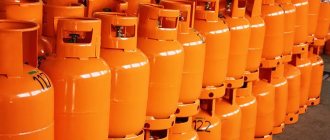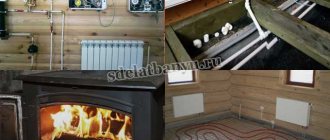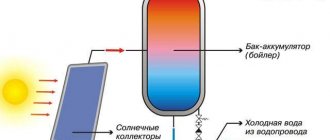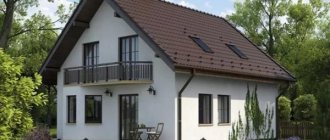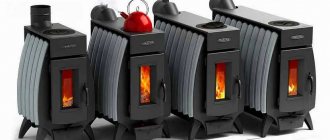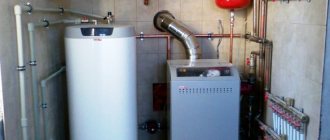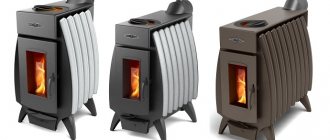If it is impossible to connect to a central gas pipeline, an alternative to switching to solid fuel or using electric heating can be heating the house with gas cylinders. This method of heating a home is by no means uncommon in our country, because in terms of its characteristics, liquefied gas is no different from main gas, although it is much more expensive.
Heating a private house with gas cylinders
Differences between liquefied and natural gas
Phases of liquefied gas in a cylinder Source otivent.com
Everyone knows that methane (CH4) predominates in the composition of a liquefied hydrocarbon mixture (hereinafter referred to as LPG). Its hydrogen (H) content is about 55%, so methane releases more heat per unit mass when burned than any other organic substance. LPG for boilers, water heaters and internal combustion engines is a homogeneous mixture of propane (C3H8) and butane (C4H10). The priority of natural gas over LPG mainly lies in its cheapness - this parameter prevails even over the high efficiency of methane during combustion.
Physical properties of propane-butane:
- heat release during combustion – 6.4 kW/1 dm3;
- under pressure, natural gas easily passes into the liquid phase and vice versa;
- LPG is pumped from storage into standard cylinders or gas tanks;
- for combustion in nozzles and cylinders of internal combustion engines, propane-butane is supplied in a gaseous state;
- As LPG is used, condensate accumulates at the bottom of the tank, as an inevitable element that occupies useful volume.
The containers into which LPG is pumped are never filled to capacity. 20% of the tank is always left empty to allow propane-butane to go into gaseous form. In standard cylinders, the net capacity is 40 liters, with the ability to pump 50 liters.
Flaws
As you can see, gas heating has many advantages. But, of course, it was not without its drawbacks. Although they are few in number, they are significant:
- Unfavorable heating method
Judging by the reviews, a system with gas cylinders can cost a pretty penny. According to the calculations of those who have tried it, 25 cylinders are needed for the winter, provided that the house area is 145 m2, the foundation is USP, the floors are warm, the temperature is set at +23°C, and 20 kg of fuel is pumped into 50 liter cylinders. Outside, the air temperature ranged from -5°C to -27°C. The average monthly temperature outside was -16°C.
- Effect of frost
If the cylinders are installed outside the house, the system may shut down due to frost. The reason is simple - the condensate freezes and prevents gas from flowing to the heating system.
- High safety requirements
If installing cylinders is not a very complicated procedure, then the safety measures that must be observed when placing and operating liquefied gas require strict implementation. They will be discussed further.
General requirements for cylinders and boilers
First of all, you should take into account the location of the rooms in the house. If there is a boiler room there, this does not mean that technical issues with the room have already been resolved, since gas cylinders cannot be in the same room with the heating device! For this purpose, you will have to equip some kind of kitchen, bedroom, etc. or make a cabinet against the wall of the building where containers will be stored. You can also dig a hole in the yard and install a steel tank there as a home gas tank.
Gas holder device
Gas holders are distinguished according to the principle of storing gaseous substances and are divided into two types: with variable and constant volume. In the variable type, the gas is stored at a pressure equal to atmospheric values. The volume of such a container changes linearly depending on filling or emptying, and the necessary pressure is created by a special bell in a cylindrical pool filled with water or by a piston in dry systems.
Second type: constant volume gas holder. That is, it is a container that does not change the internal volume depending on the amount of gaseous substance injected. As a rule, they look like a cylindrical tank. Their main advantage is the modern materials used for their manufacture, which are capable of containing gas under a pressure of 1.8 MPa.
Requirements for boilers
On the left - convection (traditional), on the right - condensation Source otivent.com
Before buying a heater to operate on LPG, you should remember that a gas boiler using gas cylinders will only function if the unit is capable of operating at a reduced pressure from 0.003 to 0.004 bar or from 2.96 to 3.94 atm. Otherwise, no fundamental changes to the equipment will be required. If this is the case, then in the technical passport of the boiler from the manufacturer there is always a section that indicates the operating conditions for liquefied gas.
Important: even if you thoroughly understand the settings and convert the unit yourself, you should not put it into operation! Before start-up, contact a nearby public or private enterprise so that the reconfiguration of the equipment can be inspected by a licensed specialist.
Selecting a boiler for conversion to LPG
Heaters differ in mounting methods Source otivent.com
Manufacturers of any gas boilers set themselves the task of increasing the efficiency of the unit as much as possible, and this, first of all, depends on the complete combustion of fuel in the system. Despite the difference in the state of methane and liquefied hydrocarbons, the principle of their combustion is no different from each other, but there are some nuances that will have to be taken into account. It should be remembered that it will not be possible to use both energy carriers (LPG and methane) at the same time, since the reconfiguration process involves partial disassembly of the boiler with the replacement and reconfiguration of some components and parts.
To select and purchase a gas boiler, you need to consider the following:
- Power. For every 10 m of residential premises with ceilings no higher than 2.7 m, 1 kW will be needed, but if the rooms are higher, then you need to calculate by volume: for every 10 m3 - 0.41 kW. Then the resulting power must be multiplied by a factor of 1.2 - this is the simplest and most reliable method of calculation.
- If the house does not have a chimney, or rather, there is no way to use it for your heater, then choose a suspended model with a closed combustion chamber. There, combustion products exit through a coaxial pipe, which is discharged through the wall directly next to the boiler.
- If your house still has a chimney, but you don’t have a lot of money, without any doubt, take a model with atmospheric draft (open combustion chamber). Such a unit will be cheaper and without losing the efficiency of heating the house.
- If you choose a double-circuit boiler, make sure that the heat exchanger is separate (one for heating, the other for DHW). This option is more convenient to maintain and more reliable in operation. Also, for a budget option, you can buy a parapet boiler - there is a coaxial pipe with the combustion chamber open, but the most powerful of them is no more than 12 kW.
Advantages
Each heating method for a private home has its own advantages and disadvantages. Knowing about them, you can decide whether one or another method is suitable for a particular home. Advantages of gas cylinder heating:
- Inexpensive fuel price. Today the cost of gas is not the most expensive in the energy market.
- Availability. Not every locality has a gas pipeline. Gas cylinders can be bought at any construction hypermarkets and pumped at special stations.
- Autonomy. Can be installed separately and does not depend on external factors. Connection does not require a gas line. The cylinder can be brought anywhere.
- Stability . Fuel is supplied under a certain pressure. It does not jump in the pipes and does not change, it flows evenly.
- Durability. The cylinders last a long time and can be refilled many times. If necessary, all equipment can be resold on the secondary market without any problems.
- Heating water. Another plus is the ability to provide the house with hot water.
Gas cylinders
Connecting cylinders
A special reducer is used to regulate the pressure Source stroyinstal.ru
Connecting liquefied propane-butane is carried out in exactly the same way as connecting natural methane, but given the fact that the LPG pressure is higher, there should be a reducer at the outlet of the manifold from the cylinders. Only it’s not the same as what you’re used to seeing when connecting a gas stove at the dacha, although the essence is the same - it’s adjusting the pressure. In our situation, it is a device with a regulator and a pressure gauge.
Is it economically profitable?
Statistics show that heating a 100 m2 building requires an average of 15 liters per day. But this parameter can vary significantly. It all depends on how insulated the house is, as well as on the air temperature outside.
Cylinders are available in different volumes: 50 l, 27 l, 10 l, 5 l. For heating a house, it is more advisable to take the largest volume - 50 liters. It holds 35-40 liters of gas. Now let's look at a simple example. To heat a house with an area of 70 m2 you will need about 2-3 cylinders for 1 week. This is provided that the temperature outside the window is -5°C. If it drops to -20°C, then heating the same house will take 5-6 cylinders for 7 days. As the square meters of housing increase, gas consumption increases proportionally.
If we add to this value the cost of gas refueling and delivery services, then heating turns out to be economically unprofitable. In addition, if the house is poorly insulated, then heat loss will increase. Accordingly, more gas will be required for home heating.
Is it possible to somehow save liquefied gas consumption?
Such a sensor is installed in a boiler room Source tion.ru
Yes, it is indeed possible if you follow all the recommendations and rules. There are not many of them, but they still exist and help save the family budget for those who adhere to them:
- Insulate the house. External insulation turns out to be more effective than internal insulation.
- Replace old windows and doors with new ones so that the shutter strips fit tightly in all places, preventing cold air from entering from the street.
- The difference in air temperature in the boiler room and the heated room should not exceed 2-3°C. To do this, in the room where the boiler is installed, you can even put a homemade register welded from a metal profile.
- Refill cylinders and tanks only at proven gas stations so that there are no foreign impurities in the LPG.
- Use automation to regulate the temperature in the heating circuit. Its indicators must correspond to the desired air temperature in the room.
- Install a monitoring sensor that detects carbon dioxide leaks. If there is one, then you will have to constantly ventilate the boiler room, which means additional costs for heating the room.
Safety precautions
Compliance with safety standards is a prerequisite for using bottled gas. The following requirements are put forward for this type of heating:
- cylinders cannot be installed in rooms without ventilation;
- must be stored in a ventilated area, under which there is no basement or basement;
- cylinders must not be dropped or left in an inclined or vertical position;
- the storage box is placed on the northern part of the house, where the shading is maximum;
- Cylinders cannot be installed in rooms with basements and plinths;
- The maximum permissible filling of the cylinder is 80%. When the temperature of the gas begins to rise, its volume increases. If the space is crowded, an explosion will occur. Even the highest strength cylinders will burst if filled to 90% in frosty air and brought into a warm room.
It is important to remember that a mixture of propane and butane is much heavier than air. When there is a leak, liquefied gas always accumulates at the bottom. At the same time, it is odorless and you can not feel the leak immediately, but only when the concentration has reached dangerous values. Therefore, the best choice is to install cylinders on the street. They must be mounted in a vertical position in a special box, in which openings are made at the top and bottom for ventilation.
Under no circumstances should cylinders be lowered into a basement, basement, subfloor or cellar, as well as into holes dug in a personal plot!
Cylinders freeze in the cold. But to heat them, it is prohibited to use heating elements, electric heaters or heating cables.
For normal operation of the heat exchanger, you need to connect it to a bunch of 4-5 cylinders. In this case, the following safety measures must be observed:
- use a pipe with a wall thickness of at least 2 mm for the gas supply pipeline;
- where the pipe passes through the wall, it is passed through a protective sleeve. The diameter of the protective sleeve should be 2-3 cm larger than the diameter of the pipe itself. The space between the pipe and the walls of the sleeve is filled with polyurethane foam.
- Steel pipes are used for gas pipelines. The thickness of their walls should not be less than 2 mm.
- The boiler is connected to the gas pipeline using flexible wiring. The reducer is connected to the gas pipeline via a rubber-fabric sleeve.
- Detachable connections must be checked for leaks. A simple method is used for this – soaping.
Efficiency
Efficiency is one of the most important parameters of a heating system. Liquefied gas is more expensive than main gas, and transportation costs must be added to its cost.
Therefore, when purchasing a boiler, you need to calculate the consumption of cylinders, taking into account the efficiency of the entire heating system.
The efficiency of modern, working equipment can reach 90-95%. To calculate gas consumption for heating, you need to know the total area of the room: approximately 1 kW of power is consumed per 10 sq.m.
Heating and water heating in a country house of 100 sq.m will require about 2 cylinders per week and 8-9 cylinders per month. You can connect cylinders into a group: according to the rules, the use of a cylinder system of up to 15 pieces is allowed. In this case, gas containers must be located in a closed metal cabinet.
Refueling
Cylinders undergo mandatory certification once every 3 years - this is necessary for the user’s own safety. Such containers can serve for about 10 years. A standard home consumes about 10-12 cylinders per month, so they will have to be refilled weekly - you cannot transport more than 3 cylinders at a time without special permission.
Before filling, the vessels need to be prepared. To do this, you need to remove condensation, which artificially reduces the useful volume and harms the steel walls. Removing condensate is the prerogative of specialists; doing such work yourself is always a risk. If for some reason it is difficult to find a specialist, you will have to carry out the procedure yourself. The cylinder is taken out to an open space without sources of fire, grounded and then the reducer is removed. Leave for 2 hours to allow any remaining gas to evaporate. After two hours of inactivity, the vessel turns over and the water flows into the ground. You can take it to a gas station.
It is worth choosing a gas station that organizes both transportation and a guarantee for the work. It is better not to contact car stations, because their equipment does not have a special cut-off valve that regulates the filling of household gas cylinders. They also do not have a special connector for connecting the cylinder to station equipment.
